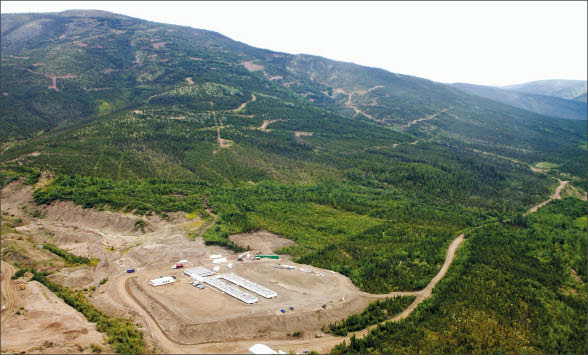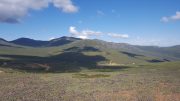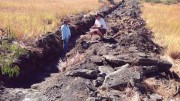With all the excitement about new discoveries in the Yukon, it’s easy to forget about the established deposits that could become mines in the near term.
Victoria Gold‘s (VIT-V) Dublin Gulch project, for example, already has a prefeasibility study on the Eagle gold deposit. The company is pushing the project through the environmental assessment process, and targets 2014 to begin producing 179,000 oz. gold per year and become the first new gold mine in the territory.
Sitting in a meeting room that forms part of the company’s well-established 100-person camp at the site, company president and CEO John McConnell explained in August that, since acquiring the property two years ago, they have completed a prefeasibility study, doubled the resource, are well along in permitting and expect a feasibility study before 2012.
“We like to think we’ve moved very quickly,” McConnell says. He adds with a smile that he has warned his exploration geologists not to get too comfortable at the camp, because they’re going to get kicked out next year as development ramps up.
He points to the squiggly red lines on a map that lead to the Dublin Gulch property, and explains with some satisfaction that they are roads. The company already has year-round road access to the property, with an agreement to tie into the electrical grid that sits 32 km away.
“That gives us long-term, low-cost power,” McConnell notes.
With the existing infrastructure, the prefeasibility study set capital costs at $280 million for the heap-leach, open-pit operation. For the feasibility study, the company is looking at costs increasing to $350 million and cash costs to US$600 per oz. gold, but McConnell notes that without a mill, it doesn’t have to worry as much about steel and cement cost escalations.
As to other project financials, the net present value (NPV) at US$900 per oz. gold with a 5% discount came in at US$104 million, and the internal rate of return at 15%. McConnell notes that the project is heavily leveraged to the price of gold, with the NPV jumping to US$482 million alongside US$1,300 per oz. gold.
The feasibility will be based on US$1,100 per oz. gold, as well as an increase in the leach-pad capacity from 66 million tonnes to 100 million tonnes while incorporating the resource update released in March. The new resource established a total indicated resource of 222.2 million tonnes grading 0.68 gram gold per tonne for 4.8 million oz. gold in granodiorite and metasediments, while inferred tonnes came in at 77.9 million tonnes grading 0.59 gram gold for 1.5 million oz. gold. The prefeasibility study, meanwhile, established reserves of 1.75 million oz. gold based on a 72% recovery rate for the heap-leach operation.
Heap leaching is not a simple endeavour in the Far North, but the company has learned quite a bit from Kinross Gold‘s (K-T, KGN-N) Fort Knox gold mine in Alaska, which has similar characteristics. And with Kinross holding 19% of Victoria shares, the major has been happy to share some advice.
Victoria has also found willing partners with the First Nation of Na-Cho Nyak Dun, with whom it signed a comprehensive co-operation benefits agreement in October. The agreement establishes the Na-Cho Nyak Dun’s support for mine development and exploration within its traditional territory, while Victoria has committed to employment and training programs as well as continued dialogue and future profit-sharing opportunities.
The agreement is significant for Victoria because, along with developing the Eagle gold deposit, it sees tremendous potential in the surrounding area.
“We’re moving full steam ahead with plans to build a mine here,” McConnell says. “But the real exciting news is the exploration work we’re doing on the property.”
The company budgeted $10 million for exploration this year, on top of the $5 million it is spending on permitting and the feasibility study, with an aim to drill 14,000 metres.
Victoria has concentrated exploration at targets like Shamrock, Olive, Steiner and Popeye, because exploration will become more challenging once mine development starts next year. But with the Dublin Gulch property spanning 30 km east-west and 10 km north-south, it has conducted preliminary exploration on several other targets including Rex-Peso, Bodach, Nugget and Whiskey Wrinkles.
“Eagle is just a small dot on that property,” McConnell says.
In August the company announced it had found a new silver and gold target at Rex-Peso, with samples of 1.81 grams gold, 1.57 grams gold and silver grades of 6,410 grams silver and 2,820 grams silver. The company is awaiting drill results from the target.
“We think we have a whole new discovery there,” McConnell says. “There’s potential for another Eagle just four kilometres to the west.”
The latest drill results from the Shamrock zone, 4 km northeast of the Eagle deposit, included 3 metres grading 21.59 grams gold, 5 metres grading 7.7 grams gold and 6 metres averaging 5.03 grams gold. At the Olive zone, 3 km northeast of the Eagle deposit, results included 15 metres carrying 3.64 grams gold and 22 metres grading 2.48 grams gold. And at the Steiner zone, directly adjacent to the Eagle deposit, the latest hole hit 29 metres carrying 1.37 grams gold.
“We’re finding gold everywhere here,” McConnell says. “It’s just a matter of piecing it together and testing whether it’s economic or not.”
While the company is focused on its Yukon properties, it also holds several Nevada projects. Victoria initiated a four-hole drill program at its 28-sq.-km Mill Canyon project in October, and has been conducting mapping and soil sampling at its Santa Fe project. The company still holds its Cove project, where it spent over US$12 million establishing a resource and a preliminary economic assessment, but largely suspended work after it lost the bulk of the high-grade resource when a database error was identified.
To move its Yukon projects forward, Victoria announced a $30-million bought-deal financing, with common shares selling at 46¢ and flow-through shares at 55¢. Meanwhile, the company has 277 million shares out, or 295 million fully diluted. Victoria’s share price closed at 46¢. It has a 52-week share price range between 32¢ and $1.48.






Tried using your STOCK QUOTE link. Appears it don’t like Canadian stocks. ie. tried VIT-V. Got a report, ‘not a valid symbal’.